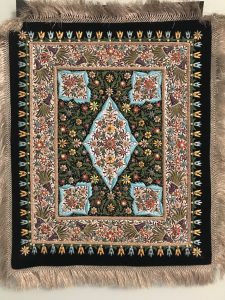80th Birthday Tribute to Harriet Gove O’Daffer (24 page booklet)
My wife, Harriet, passed away on September 27, 2021, after a thirteen year battle with Azheimers.
About 5 years into her illness, on July 6th, 2013– to honor her, and to provide a reference for our kids and grandkids about what she had accomplished– I wrote an “80th Birthday Tribute to Harriet Gove O’Daffer.” Harriet greatly enjoyed reading and rereading this tribute with family, friends, and caregivers.
Feel free to download this booklet, and remember again this wonderful woman.
Download a 24-page 80th Birthday Tribute to Harriet Gove O’Daffer written and published by Phares O’Daffer in 2013.
An Unknown Roque Champion
When I was entering into my teenage years, a game we called “croquet” was really becoming popular in downstate Illinois.
My niece, Nancy Casey, writes eloquently of her memories of it:
Weldon is a small town in central Illinois — farm country. When I was four or five, my dad, Uncle Ike, and Grandpa would take me at night to the croquet court at the end of Main Street, just across from the hotel that my Great Grandma Gray ran.
It was all lit up with overhead lights and all the men had their own wooden croquet mallets. My mom Wanda, now 94, still has two of them. The men played while I watched. The court seemed pretty big to me.
Because of this introduction to the game, we always had a croquet set when my son Scott was growing up and we played in the back yard. I now have a very fancy croquet set that Scott got me for Christmas one year.
One time when we visited Scott’s Simon Island house, we drove over to Jeckyl Island where there is a big fancy hotel with a huge grass croquet court in front of it. All the people were out in all white clothes playing croquet.
It may be a sophisticated game, but I remember Weldon and all the men playing croquet on a summer’s eve in the middle of the midwest farm country.
As Nancy observes, people played “lawn croquet,” where you set up thin wire arches in your sometimes bumpy yard, and use a long handled mallet to hit wooden balls through them.
Invented in France and brought to the U.S. from England, it was a game that provided entertainment for a lot of people.
But as Nancy also hinted, the game the men she watched were playing, lights and all, was different– and therein lies this tale.
So What Made Our Game Different?
The “croquet court” the men built and played on in my hometown, Weldon, Illinois, looked a lot like the court below, if you throw in some lights.
The Weldon court was surrounded by a six-inch high concrete wall, had a hard clay surface that was lightly covered by sand. The arches were made of steel, one inches thick. The game used a hard rubber ball, about three and a quarter inches in diameter, which barely went through the arch.
The mallet the men of Weldon used had a 15-inch handle. The head of the mallet, with soft rubber on one end and hard rubber on the other, was nine inches long. My dad’s mallet and ball are shown in the photo above.
Contrary to the “minor league” game of lawn croquet, this court croquet was a “major league” game of true shots and creative skill. We didn’t know the history or true name of our game, but we sure loved to play it.
My Grandfather, Emmett Gray, even built a court similar to the one shown above in the back yard of his home in Weldon.
A Revelation Late in Life
I was avidly playing our court croquet game when I was 12 years old, but it wasn’t until 75 years later — spurred on by some questions after a talk I gave — that I really found out what was going on.
To my surprise, I found the following definition in Dictionary.com:
Roque (noun) a form of croquet played on a clay or hard-surface court surrounded by a low wall off which the balls may be played.
And the following from Wikipedia, and the Encyclopedia of Sports:
Roque is an American variant of croquet played on a hard, smooth surface. Popular in the first quarter of the 20th century and billed “the Game of the Century” by its enthusiasts, it was an Olympic sport in the 1904 Summer Games, replacing croquet from the previous games.
Roque is played on a hard sand or clay 30 ft by 60 ft court bordered by a boundary wall, a curb bevelled at the ends to form an octagon. Players use a short handled mallet (15″-24″ long) to bank balls off the boundary wall similarly to how billiard balls are played off the cushions of a billiard table.
Lo and behold! I was playing roque and didn’t even know it!
A Little More Roque History
The roque players really thought they were on to something. A better game than croquet, invented right here in America! The Game of the Century.
According to Wikipedia,
The name “roque” was suggested by Samuel Crosby of New York City in 1899 who came to it by removing the initial “c” and final “t” from “croquet.”
C\ROQUE\T
The National Croquet Association, formed in 1882, thereafter changed its name to the National Roque Association in 1899.
To bring it close to home, the following is from Wikipedia, no less.
Roque is still played by a small number of people in the United States. An historic roque court in Clinton, Illinois was restored to playing condition in 2013. A roque tournament is held annually in Angelica, New York.
One Guy’s Experience With Roque
At my dad Ray Odaffer’s funeral in March 1950, as the shock of the farm accident that took his life was waning, people talked about how much he loved to play croquet.
Before that, my dad had talked about he and I playing in a croquet tournament sometime.
Sadly, my dad’s bucket list wouldn’t be completed. When I started to play again, I wondered if I should use his mallet, instead of my cheaper, youth mallet. Somehow, it didn’t seem right.
But over a year after he died, in August 1951 I decided to honor my dad by using his mallet in what I now know was the Little State Roque tournament in Clinton, Illinois.
I couldn’t do anything wrong. It seemed that every shot was perfect. I won the tournament going away! It felt like my dad was hitting the shots, not me. And maybe he was.
And I have a ribbon to prove it.
 Some Final Comments
Some Final Comments
Now, 70 years after that tournament, I am still honestly puzzled that roque did not make it as “The Game of the Century.”
It had everything: skill, creativity, cleverness, strategy, and steadiness. It was like standing on a giant billiard table. You could get better through practice and it was a lot of fun to watch. Wonderful competition!
Some people say it died out because television was coming in a big way, and roque players watched TV instead of using their time to play this enticing, exciting game.
So hard to understand. I still hold out hope that the game will be re-discovered and everybody will learn to love it.
But then I may be just wanting myself to be re-discovered as the Little State Illinois roque champion of 1951. Why not?
One Guy’s Caregiver Experience
Recently I received a call from a caregiver group at our church. Since I had just ended a 13-year stint as caregiver for my wife Harriet who had Alzheimer’s, they asked me to talk to them about my experiences as a caregiver.
In the fall of 2007, my family and I noticed that Harriet, always attentive to details, was exhibiting an unusual amount of forgetfulness. She was soon diagnosed as having mild cognitive impairment.
Her neurologist told me that the mild cognitive impairment might or might not progress into Alzheimer’s. Only time would tell.
His prescribed drugs, Aricept and Namenda, were not curative and would only possibly slow the possible progression.
I’m not sure about slowing, because 13 years later Harriet had progressed through five of the five stages of Alzheimers, and died after a fall fractured her hip.
My Reservations
I delayed agreeing to talk to the caregiver group because I didn’t want to portray myself as some sort of expert.
The truth is that I probably know less about caregiving for Alzheimer’s than most because I relied primarily on just being there and seeing what was happening to discover effective ways to cope and deal with Harriet’s terrible situation.
But, I finally decided that I might have something to say that could help people cope with caring for someone with Alzheimer’s. So the following is an adaptation of what I said to the group.
The Terrible Progression of Alzheimer’s
According to a Mayo Clinic reference, Alzheimer’s Disease goes through five stages, progressing from only scientific detectable changes in the brain, through mild changes in memory/thinking ability, then through greater difficulty in completing/remembering complex tasks or ideas.
In the last two stages, the person shows significant changes in personality and behavior and needs total dependence upon others for personal care and existence.
The Brutal Truth About Alzheimer’s
As I began to understand what was happening to Harriet, I accepted the following two truisms, and they helped me clarify my task as a caregiver.
Truism 1: People with Alzheimer’s, especially in later stages, don’t do most of what they do on purpose, and generally can’t control their actions.
Now, before reading the second truism, think of the long list of all the normal things a person can do just prior to being diagnosed with the disease.
Truism 2: People with Alzheimer’s will probably not be able to do hardly any of these things at the end when the disease has run its course.
And you never really know in advance when they won’t be able to do something today that they were able to do yesterday. You, as caregiver, are a facilitator of transitions through the stages.
How Did I Want to Be As a Caregiver?
Remembering that “You can’t control what happens, but you can control how you react to it,” and knowing that I wanted Harriet’s terrible progression through the disease to be as kind, loving, and meaningful as possible, I decided to take the following vows.
Much like my marriage vows, they totally shaped my approach and attitude toward being Harriet’s caregiver.
Also, I decided early on that when something humorous came up, I would not feel guilty laughing about it. I always felt I was not laughing at Harriet, but rather laughing as a sort of rebellion against the horrible disease.
And I also felt it was much better in the situation to laugh than to cry. So if any of my incidents illustrating a vow strike a chord of humor in you, feel free to join me in a good laugh.
My Caregiver Vows
- I will always treat Harriet with Unwavering Kindness
Very early on in her disease, Harriet drove us to Walmart. I asked her to wait at the front while I went to buy something. When I returned, Harriet, and our car, were gone. She had driven home without me. I tested my first vow that day.
- I will always treat Harriet with Loving Acceptance
As I tried to get Harriet once to help me find her lost hearing aids, I noticed that she was vigorously chewing away on something. You guessed it, the hearing aid! This second vow kept me from lecturing her that chewing up your hearing aids is a no-no.
- I will always treat Harriet with Infinite Patience
At the dinner table in our senior living community, Harriet started taking her neighbors utensils and sometimes their food. I would carefully explain to her why she shouldn’t do this, and give them back, only to have her take them again, and again. Finally, finding a workable diversion solved the problem, and reinforced how much patience I was going to need.
- I will always foster Co-Decision Making when caring for Harriet
Rita, Harriet’s other caregiver, once bought Harriet a red top that looked like a common red handkerchief. Realizing it didn’t fit Harriet’s style, Rita decided to return it. The next day, Harriet turned to me, totally out of the blue, and said “I really like my new red top.” Needless to say, she wore that top the rest of her life.
- I will always try to Give Total Attention when helping Harriet
In the last stages of her disease, it got difficult getting Harriet to eat and drink enough. I can remember working with her for 20 extra minutes, just to get her to finish a glass of water or juice. You simply needed to “stick with it” and pull out all the stops so she would get nourishment and not get dehydrated.
6. I will always try to find ways to Welcome Laughter into Harriet’s care
Near the end of her life, I was feeding Harriet some amber colored chicken noodle soup when the TV tray got bumped and the soup spilled on my pants. Looking at the soup color and where it spilled on my pants, we both started laughing and got “too tickled to stop.” I really cherished that kind of laughter.
Digging a Little Deeper Into a Caregiver’s Role
Beyond being deliberate about my attitudes, some other things I found really important in caring for Harriet are listed below with illustrations.
Other Helpful Things a Caregiver Can Do
- Establish Consistent Patterns in daily activities
Harriet’s pattern for bedtime was: start at 8:30 pm, put on bedclothes, stop for a hug (tell her she is the best hugger in the world), put her in bed, and say a prayer (naming family and friends and affirming God’s love for her). I think this pattern was one reason why she was such a good sleeper.
- Keep Them Involved as long as possible
Harriet loved coloring, golf, driving the car, bridge, choir, crossword puzzles, reading, listening to music, poems, and watching sports. My goal was to keep her doing these things as long as she could do them. The following picture she colored halfway through her Alzheimer’s journey illustrates this.
(Click on the picture to see Harriet’s signature. Click the arrow in the upper left of the screen to return.)
3. Find Their Key and integrate it into their daily activities
Harriet’s key was music. One evening Harriet and I were sitting on the couch and I was running through the TV channels. I came to Pink concert and was focused on going right past it when I saw Harriet slapping her leg to the beat. Needless to say, Harriet and Pink really enjoyed the next half hour.
- Facilitate Their Transitions as smoothly as possible
Harriet always waited patiently outside the bathroom at the ISU basketball games while I finished inside. One night, as I started going out, Harriet started coming in. She was met by men, telling her in no uncertain terms, “Lady, you can’t come in here.” Clearly, another transition was upon us.
- Keep Them Connected to their past
I wrote this 23 page tribute to Harriet when she was halfway through her Alzheimer’s experience. I wanted her to be able to remember her past, and I wanted her kids and grandkids to remember her like she was pre-Alzheimer’s. Harriet looked at the booklet a lot with her family. I think she was proud of it.
Some Final Thoughts About Being a Caregiver
People always tell caregivers to “take care of themselves,” and that is certainly true. I totally bought into this, and looked for ways maintain some sensibility and balance in my life throughout the whole process. Here is what worked for me.
How to Keep Your Caregiver Sanity
- Make time for Yourself
Having Rita to help with Harriet for several hours each week was so valuable, for Harriet, Rita, me, and others. It certainly helped my golf game and my fun at the library. When my son Eric came on several occasions to stay with Harriet for a few days while I went places with my daughters, Rita helped him with certain things. Eric called her “Rita from Heaven.”
- Accept Help in Decision Making
From “When should we go to a retirement community?” to “Is it time for hospice?,” there are many decisions to be made. I was blessed to have a great relationship with three wise and wonderful adult children (Sue, Sara, and Eric) who fully participated in all those major decisions. It really helped.
3. Keep a Sense of Humor
As I picked Harriet up from a History Club meeting once at Al and Linda Bowman’s house, instead of her cute purple frame glasses, she had on a pair of larger, manly glasses. Al’s glasses? A large club–woman’s glasses? Nope. Mystery unsolved! Harriet and I had a good laugh. And I still have the glasses.
- Take Things in Stride
From asking Harriet to go in the bathroom and take off her hose for a pedicure and having her come out with both hose and pants off, to having her leave the car and go into a store while I was busy pumping gas, we all learned the importance of “taking things in stride” and “not sweating the small stuff.”
5. Treasure the Little Things
One time, Harriet, who was hurrying across the room, saw me on the couch, broke stride, came over to me, smiled, and pulled my big toe. Other times, in the same situation, she smiled, patted my leg, or gave me a “thumbs up.” I was always on the lookout for little things, like her saying, “He’s my husband.” That made all the difference for me.
6. Honor Your Loved One
Once my caregiver life was over, it was great therapy for me to honor Harriet for the things she put up with during her long bout with Alzheimer’s. I make a collage of pictures on one of my walls, accompanied by a tribute to Harriet. It gave me the final closure that all caregivers of loved ones must have.
A Tribute to Harriet, by Phares
Harriet, my special lady, died on September 27, 2020, after a 13 year battle with Alzheimer’s disease.
The photo above on the left is representative of her vibrant years as a wife, mother, teacher, friend, and amazing community volunteer –a liver and lover of life, and an acceptor of responsibility. It dramatically reminds me of her unwavering spirit of love, friendliness, helpfulness, cooperation, and love of adventure.
I can tell you for sure that she was, as she appears, a real winner — a truly wonderful woman.
The photo above on the right was taken in her latter stages of Alzheimer’s. I love the photo because the expression on her face also tells a story. With all the awful things she had to deal with in coping with this terrible disease, Harriet’s facial expression above reminds me how she tackled the disease with dignity, even when everything was against her.
Somehow, she found a way to rarely be angry, to maintain her pleasant look, pat me on the knee or pull my toe, and often sport a full fledged smile. I always felt, even in the toughest times, she was trying to be helpful, and make things for me as easy as she could.
So join me in this tribute to Harriet. She was special all her life!
Some Concluding Comments
I would be remiss not to emphasize how much the support of family and friends helps you as a caregiver.
In addition to our kids, the spouses of our kids, our grand kids, our friends, the staff at Luther Oaks, and many of our relatives were always very attentive to Harriet’s needs. They really gave her the time of day!
For example, our daughter-in-law, Stacy wrote Harriet an interactive card every day for long periods of time. It become a ritual for Harriet and I to read them and answer Stacy’s questions.
Harriet’s brother Jack and his wife Jean wrote Harriet a letter every week, and so did Harriet’s sister Ellen. Reading those letters with Harriet helped a lot.
In fact, I see all of these people as “assistant caregivers,” and treasure all of their input, much of which I haven’t mentioned.
A Final Caveat
If you are thinking that what I’ve told you in this post is too good to be true, you are a good judge of what it means to be human.
I set high standards for how I wanted to be as a caregiver and how I wanted to help Harriet cope with the suffering caused by Alzheimer’s.
I wasn’t perfect.
Sometimes, I look back on things and wished I had handled some of them differently. I even bent a vow a little now and then to accomplish what I thought I had to do.
But I always tried as hard as I could to keep my vows, have a good attitude, and create as pleasant and loving experience for Harriet as possible. And other people did too.
I think she noticed.
Zeroing In On Zoom
I wonder what my mother Ruby, who at 97 years of age could hardly believe the reality of the Internet, would think of Zoom calls today?
“Talking to and seeing my kids and grandkids from all over the country ‘alive’ on one screen? How can this happen?” she would surely ask.
How Did Zoom Happen?
In 1994, a young Chinese man told his girlfriend, who lived 10 hours drive away, that he would someday invent a way that they could see and talk to each other or to a group of their friends, from a distance.
That young man, Eric Yuan, fresh out of college, also heard a speech by Bill Gates about the Internet that inspired him to come to the U.S. and fulfill his dream to start a teleconferencing company. After eight failed attempts to get a visa, Yuan finally got one, and the rest is history.
Yuan got backing, implemented his creative ideas, and Zoom was started in 2013, well before the onslaught of the coronavirus. Zoom has now grown to a $35 billion company, and Yuan’s personal wealth was recently listed at $16.7 billion. Quite a story from the monetary success standpoint. But let’s look at the rest of the story.
What Did (Does) Zoom Do For Us?
Since the onslaught of the coronavirus, many of us have been led, inexorably, to one Zoom meeting after another.
It almost seems that someone who has not been in a Zoom meeting is like someone who has never eaten ice cream– bordering on being an oddity.
My guess is that in this era of the coronavirus, Eric Yuan gets a great deal of personal satisfaction knowing that his creation is helping people all over the world to get together with their families, conduct business, fellowship with church and other groups, and just keep in touch — all from the cozy atmosphere of their own homes.
(To enlarge the photo, click on it. To return, click on the arrow at the top left of your computer screen.)
Zoom has greatly helped us communicate with each other, maintain our psychological health, and reduce the stress of tangling with the virus. Thanks a heck of a lot, Mr. Yuan!
And, oh, I forgot. Zoom has also provided us with quite a lot of humor, on what could be pretty dreary days. Let me tell you what I mean.
Are We Zoomers Funny, or What?
So many of us are using Zoom, that it wouldn’t be far fetched to refer to us as Zoomers, or Zoomies (I prefer Zoomers).
Having been involved in several Zoom meetings, I’ve watched us Zoomers carefully, and have gotten several good laughs.
So let me tell you about the different types of Zoomers I’ve met, some of whom may be me.
The Far Sighted Zoomers: Those who sit so far from their screens that one can only guess that they are there — a small blot in the distance, causing others on the call to go for their telescopes.
The Near Sighted Zoomers: Those who sit so close to the screen that their images are distorted, like they would look if they were primping in front of a magic mirror.
The Shadow Zoomers: Those sit just the right distance away from the screen, but are perplexed because they appear to be almost in total darkness, oblivious to the idea that it would help to turn on a light.
The Half-There Zoomers: Those who slouch down in their chair so far that only the top half of their face shows on the screen. Either they are trying to remain incognito, or can’t “see themselves as others see them.”
The St.Vitus Dance Zoomers: Those who can’t sit still, always moving around on or off their chairs for no apparent reason. They, like their distant ancestor who had St. Vitus Dance, simply need to be always on the move.
The Gorging Zoomers: Those who pile on calories the whole time — always snacking during the meeting. Others wonder why they always have their meetings at this Zoomer’s mealtime.
The Mostly-Muted Zoomers: Those who never turn off their mute button until their fellow Zoomers all stare at them and cup their hands to their ears.
The Chatty Zoomers: Those who spend 80% of the meeting writing chat notes to people at the meeting, while ignoring what the meeting is all about. Sometimes these Zoomers are asked to take minutes of the meeting.
The Tardy Zoomers: Those who can never get to the meeting on time, taking an extra 10 minutes beyond the start of the meeting to find the meeting invitation and click the right place to get into the meeting. These Zoomers often ask, “What are we talking about?
The Otherwise-Involved Zoomers: Those who don’t really want to attend the meeting, and so they spend the whole time with their image blackened out, while they work out on a treadmill. These Zoomers would tell you that they are good at multi-tasking
The Loud Zoomers: Those who somehow feel that they have to shout to be heard by all those people on the Zoom call. The resulting effect is that ear plugs often have to be passed out at meetings.
The Self-Conscious Zoomers: Those who keep taking a peek at themselves to see if everything is alright with their image on the screen. Sometimes they try to disguise the peek by looking out out the corner of their eye, but it’s still a peek. The solution is to push Stop Video so no one can see you.
I’m sure you recognize some of these Zoomers and have met others I’ve failed to mention. For example, the last two categories above were suggested after this post was published by my daughters, Sue and Sara, and I felt they just had to be included. Surely we will find other recognizable types of Zoomers as time goes on, but as of now, that’s us!
So What’s The Bottom Line on Zoom?
Would you have believed, even a year ago, that people all over the country would start off 2021 spending countless hours each week in Zoom meetings?
And don’t be embarrassed if you feel a little like my mother would, scratching your head and asking, “How can this happen?”
So here we are — the Zoomers! We are getting better at the game, and will undoubtedly cull out any bad Zoom habits as time goes on.
My advice to you during this Zoom trend is “If you can’t lick it, join it (and enjoy it).” And don’t expect it to be obsolete any time soon!


